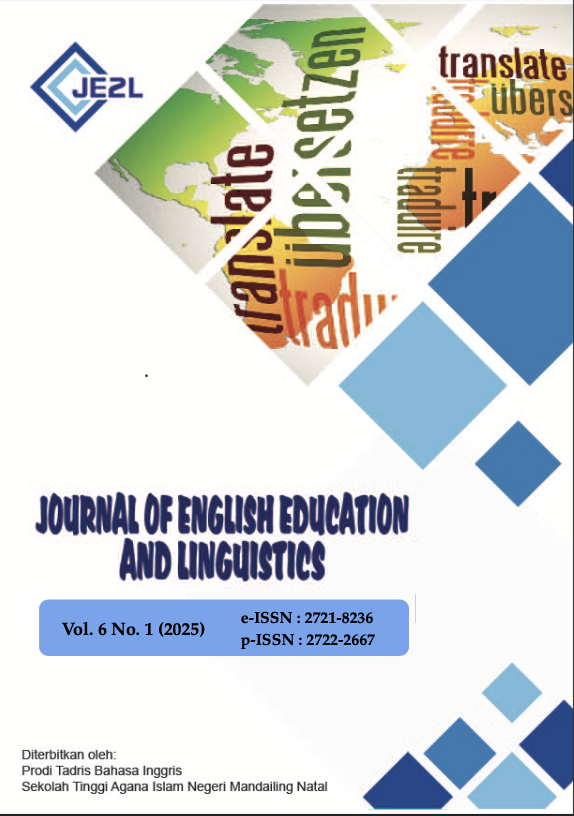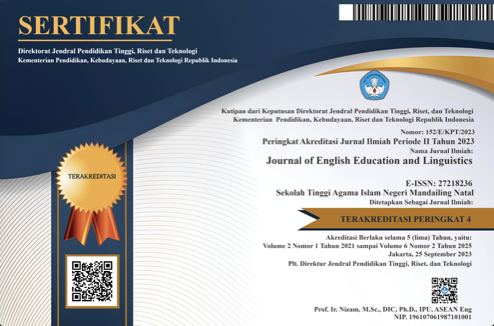UTILIZING KNOWORD TO IMPROVE VOCABULARY ACQUISITION IN HIGH SCHOOL STUDENTS
DOI:
https://doi.org/10.56874/jeel.v6i1.2057Keywords:
Vocabulary Acquisition, Knoword, Gamified Learning, Student Motivation, Classroom Action ResearchAbstract
This study aims to investigate the effectiveness of Knoword, a gamified online tool, in improving students' vocabulary acquisition. Vocabulary mastery plays a crucial role in language learning, yet many students, particularly in public schools, struggle with insufficient vocabulary knowledge due to factors like low engagement and traditional teaching methods. This research addresses these challenges by exploring how digital tools can enhance learning outcomes. The study employed Classroom Action Research (CAR) as the methodology, conducted in a public high school in Batam with 42 students in the 10th grade. The research process consisted of a learning cycle involving planning, action, observation, and reflection. Pre-tests and post-tests were administered to measure students’ vocabulary skills before and after implementing Knoword. Observations during classroom sessions also provided qualitative data on student engagement and motivation. The results showed a significant improvement in students' vocabulary acquisition. The average pre-test score was 51.59, categorized as poor, while the post-test score increased to 83.05, classified as good, with a 31.47% improvement. The findings indicate that the use of Knoword enhanced students' motivation, engagement, and vocabulary retention, making it an effective tool for vocabulary learning. The study concludes that incorporating gamified learning platforms can significantly improve vocabulary acquisition and student outcomes, especially in educational environments where traditional methods have shown limited effectiveness.
References
Arikunto, S. (2015). Penelitian Tindakan Kelas (Classroom Action Research-CAR).
Berry, K. J., Johnston, J. E., & Mielke, P. W. (2019). Central tendency and variability. In K. J. Berry, J. E. Johnston, & Jr. Mielke Paul W. (Eds.), A Primer of Permutation Statistical Methods (pp. 83–100). Springer International Publishing. https://doi.org/10.1007/978-3-030-20933-9_4
Bouchrika, I., Harrati, N., Wanick, V., & Wills, G. (2019). Exploring the impact of gamification on student engagement and involvement with e-learning systems. Interactive Learning Environtments, 1244–1257. https://doi.org/10.1080/10494820.2019.1623267
Cristea Ple?an, N. (2021). The method of observing the student’s behavior in the educational environment. MATEC Web of Conferences, 342, 11009. https://doi.org/10.1051/matecconf/202134211009
Duff, P. A. (2019). Social dimensions and processes in second language acquisition: multilingual socialization in transnational contexts. Modern Language Journal, 103, 6–22. https://doi.org/10.1111/modl.12534
Gortaire Díaz, D., Sandoval Pérez, M. J., Romero Ramírez, E., & Mora Aristega, J. (2022). Case Study: Gamification as a strategy for vocabulary learning in university students. Ciencia Latina Revista Científica Multidisciplinar, 6(6), 7992–8005. https://doi.org/10.37811/cl_rcm.v6i6.3970
Handig, J. E. R., San Gabriel, A. M., M. Gracia, R. B., & Domingo, M. (2023). Enhancing vocabulary learning in elementary language education: exploring effective strategies and interactive approaches. EPRA International Journal of Multidisciplinary Research (IJMR) -, 9(8). https://doi.org/https://doi.org/10.36713/epra14166
He, J., Hao, W., & Kim, J.-W. (2019). The effects of instant feedback sysrem on course interest and academic achievement in gamification learning. 2nd Eurasian Conference on Educational Innovation 2019, 467–470. https://doi.org/10.35745/ecei2019v2.119
Hwang, G. H., Chen, B., Chen, R. S., Wu, T. T., & Lai, Y. L. (2019). Differences between students’ learning behaviors and performances of adopting a competitive game-based item bank practice approach for learning procedural and declarative knowledge. Interactive Learning Environments, 27(5–6), 740–753. https://doi.org/10.1080/10494820.2019.1610458
Iswara Jaya, F. A., Yahya, A., & Jufriadi, J. (2020). National examination in SMPN 2 Palopo: a case study on students’ readiness in english test. International Journal of Asian Education, 1(2), 107–116. https://doi.org/10.46966/ijae.v1i2.38
Karlik, M. (2023). Exploring the impact of culture on language learning: How understanding cultural context and values can deepen language acquisition. International Journal of Language, Linguistics, Literature and Culture, 02(05), 05–11. https://doi.org/10.59009/ijlllc.2023.0035
Kozhevnikova, E. (2019). The impact of language exposure and artificial linguistic environment on students` vocabulary acquisition. PEOPLE: International Journal of Social Sciences, 5(1), 4. https://doi.org/10.20319/pijss.2019.51.430439
Marsevani, M., & Habeebanisya. (2022). A classroom action research: improving speaking skills through work in pairs technique. TLEMC (TEACHING & LEARNING ENGLISH IN MULTICULTURAL CONTEXTS), 6(1). https://doi.org/https://doi.org/10.37058/tlemc.v6i1.4834
Medalia Cadiz-Gabejan, A. (2022). A comparative study on the english proficiency of students from public and private schools. Journal of English Language Teaching and Applied Linguistics, 4(3), 10–23. https://doi.org/10.32996/jeltal
Meesuk, P., Sramoon, B., & Wongrugsa, A. (2020). Classroom action research-based Instruction: the sustainable teacher professional development strategy. Journal of Teacher Education for Sustainability, 22(1), 98–110. https://doi.org/10.2478/jtes-2020-0008
Naodin, Y., & Siliwangi, I. (2022). Improving students’ vocabulary mastery using song and game in elementary school. Professional Journal of English Education, 5(4).
Pérez-Lemonche, Á., Stewart, J., Drury, B., Henderson, R., Shvonski, A., & Pritchard, D. E. (2019, June 24). Mining students pre-instruction beliefs for improved learning. Proceedings of the 6th 2019 ACM Conference on Learning at Scale, L@S 2019. https://doi.org/10.1145/3330430.3333637
Raes, A., Detienne, L., Windey, I., & Depaepe, F. (2020). A systematic literature review on synchronous hybrid learning: gaps identified. Learning Environments Research, 23(3), 269–290. https://doi.org/10.1007/s10984-019-09303-z
Rafiola, R. H., Setyosari, P., Radjah, C. L., & Ramli, M. (2020). The effect of learning motivation, self-efficacy, and blended learning on students’ achievement in the industrial revolution 4.0. International Journal of Emerging Technologies in Learning, 15(8), 71–82. https://doi.org/10.3991/ijet.v15i08.12525
Rosyada, A., & Apoko, T. W. (2023). Investigating english vocabulary difficulties and its learning strategies of lower secondary school students. JOLLT Journal of Languages and Language Teaching, 11(3), 489. https://doi.org/10.33394/jollt.v%vi%i.8404
Sari, D. P., & Zaki, L. B. (2022). The use of dictogloss to improve students’ writing in muhammadiyah plus secondary school batam. Jurnal of English Pedagogy, Linguistics, Literature, and Teaching, 10. https://doi.org/https://doi.org/10.35194/jj.v10i2.2606
Selvarasu, E., Thomas, A., Sundareswaran, I., Abdul Rahaman, Farzana, S., & Pareli, M. K. (2021). Teaching writing using online tools: an experimental study at the university of technology and applied sciences. International Journal of Linguistics, Literature and Translation, 4(6), 196–201. https://doi.org/10.32996/ijllt.2021.4.6.22
Sulistiyarini, D. (2016). The influence of motivation, learning styles, teacher leadership, and teaching intensity on students’ leaning outcomes. Jurnal Pendidikan Teknologi Dan Kejuruan, 23(2). https://doi.org/10.21831/jptk.v23i2.13181
Tugayeva, D., & Dukembay, G. (2021). Incorporating web 2.0 tools into foreign language teaching. National Center for Higher Education Development. https://api.semanticscholar.org/CorpusID:259775118
Wahyuni, S. (2020). Islamic junior high school teachers’ perceptions, practices and problems in donducting classroom action research. Journal of Islamic Education. https://doi.org/10.30762/didaktika.v8i1.2188
Wen, R. (2021). The strategies of stimulating high school students’ interest in learning english in class hours. Learning & Education, 10(2), 62. https://doi.org/10.18282/l-e.v10i2.2270
Yudha, H. T., & Mandasari, B. (2021). The analysis of game usage for senior high school students to improve their vocabulary mastery. Journal of English Language Teaching and Learning (JELTL), 2(2), 74–79. http://jim.teknokrat.ac.id/index.php/english-language-teaching/index
Yulianti, S., Nuraeni, S., Parmawati, A., Siliwangi, I., & Com, S. (2019). Improving students’ writing skill using brainswriting strategy. 2(5). https://doi.org/10.22460/project.v2i5.p714-721
Downloads
Published
Issue
Section
License
All articles published in the Journal of English Education and Linguistics are licensed under a Creative Commons Attribution-ShareAlike 4.0 International (CC BY-SA) license. This means anyone is free to copy, transform, or redistribute articles for any lawful purpose in any medium, provided they give appropriate attribution to the original author(s) and Journal of English Education and Linguistics, link to the license, indicate if changes were made, and redistribute any derivative work under the same license.
Copyright on articles is retained by the respective author(s) without restrictions. A non-exclusive license is granted to the Journal of English Education and Linguistics to publish the article and identify itself as its original publisher, along with the commercial right to include the article in a hardcopy issue for sale to libraries and individuals.
Although the conditions of the Creative Commons Attribution-ShareAlike 4.0 International (CC BY-SA) license do not apply to authors (as the copyright holder of your article, you have no restrictions on your rights), by submitting to the Journal of English Education and Linguistics, authors recognize the rights of readers and must grant any third party the right to use their articles to the extent provided by the license.

This work is licensed under a Creative Commons Attribution-ShareAlike 4.0 International License.








